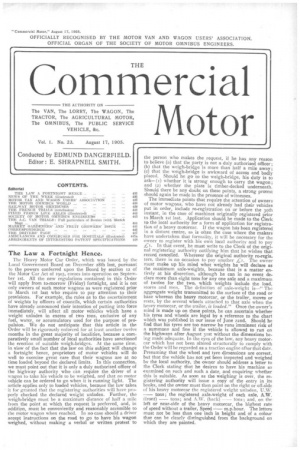The Law a Fortnight Hence.
Page 1

If you've noticed an error in this article please click here to report it so we can fix it.
The Heavy Motor Car Order, which was issued by the Local Government Board on December 28th last, pursuant to the powers conferred upon the Board by section 12 of the Motor Car Act of 1903, comes into operation on September 1st. All the new regulations contained in this Order will apply from to-morrow (Friday) fortnight, and it is not only owners of such motor wagons as were registered prior to March 1st last who require to pay attention to their provisions. For example, the rules as to the ascertainment of weights by officers of councils, which certain authorities have already announced their intention of putting into force immediately, will affect all motor vehicles which have a weight unladen in excess of two tons, exclusive of any fuel, water, or accumulators used for the purpose of propulsion. We do not anticipate that this article in the Order will be rigorously enforced for at least another twelve months in the great majority of localities, because a comparatively small number of local authorities have sanctioned the erection of suitable weigh-bridges. At the same time, in view of the fact that the law on this subject will change a fortnight hence, proprietors of motor vehicles will do well to exercise great care that their wagons are at no time loaded beyond the declared limits. In this connection, we must point out that it is only a duly authorised officer of the highway authority who can require the driver of a wagon to take his vehicle to be weighed, and that no motor vehicle can be ordered to go when it is running light. The article applies only to loaded vehicles, because the law takes it for granted that the registering authorities will have properly checked the declared weight unladen. Further, the weigh-bridge must be a maximum distance of half a mile from the point at which the request is preferred, and, in addition, must be conveniently and reasonably accessible to the motor wagon when reached. In no case should a driver accept instructions on the road to go to have his wagon weighed, without making a verbal or written protest to
the person who makes the request, if he has any reason to believe (a) that the party is not a duly authorised officer ; (b) that the weigh-bridge is more than half a mile away; (c) that the weigh-bridge is awkward of access and badly placed. Should he go to the weigh-bridge, his duty is to ask—•(z) whether it is strong enough to carry the wagon; and (2) whether the plate is timber-decked underneath. Should there be any doubt on these points, a strong protest should again be made in the presence of witnesses. The immediate points that require the attention of owners of motor wagons, who have not already had their vehicles put in order, include re-registration on or before the 30th instant, in the case of machines originally registered prior to March 1st last. Application should be made to the Clerk to the local authority for a form of application for registration of a heavy motorcar. lithe wagon has been registered in a distant centre, as is often the case where the makers have undertaken that formality, it will be necessary for the owner to register with his own local authority and to pay
In that event, he must write to the Clerk of the original registering authority notifying him that he wishes that record cancelled. Wherever the original authority re-registers, there is no occasion to pay another Li. The owner must make up his mind what weights he will declare as the maximum axle-weights, because that is a matter entirely at his discretion, although he can in no event declare more than eight tons for any one axle and a maximum of twelve for the two, which weights include the load, stores and men. The definition of axle-weight is—" The aggregate weight transmitted to the surface of the road or base whereon the heavy motorcar, or the trailer, moves or rests, by the several wheels attached to that axle when the heavy motorcar, or the trailer, is loaded." Once the owner's mind is made up on these points, he can ascertain whether his tyres and wheels are legal by a reference to the chart which was published in our issue of June 22nd. Should he find that his tyres are too narrow he runs imminent risk of a summons and fine if the vehicle is allowed to run on the highways after August 31st without the dimensions being made adequate. In the eyes of the law, any heavy motorcar which has not been altered structurally to comply with the Order will be regarded as a traction engine after that date. Presuming that the wheel and tyre dimensions are correct, but that the vehicle has not yet been inspected and weighed by the local authority, the owner should address a letter to the Clerk stating that he desires to have his machine so examined on such and such a date, and enquiring whether this is suitable. As soon as the weighing is over, the registering authority will issue a copy of the entry in its books, and the owner must then paint on the right or off-side of his heavy motorcar the registered weight unladen, U.W. — tons; the registered axle-weight of each axle, A.W. (front) — tons; and .1.W. (back) — tons; and, on the left or near-side of the heavy motorcar, the highest rate of speed without a trailer, Speed — m.p.hour. The letters must not be less than one inch in height and of a colour that can be clearly distinguished from the background on which they are painted.
















